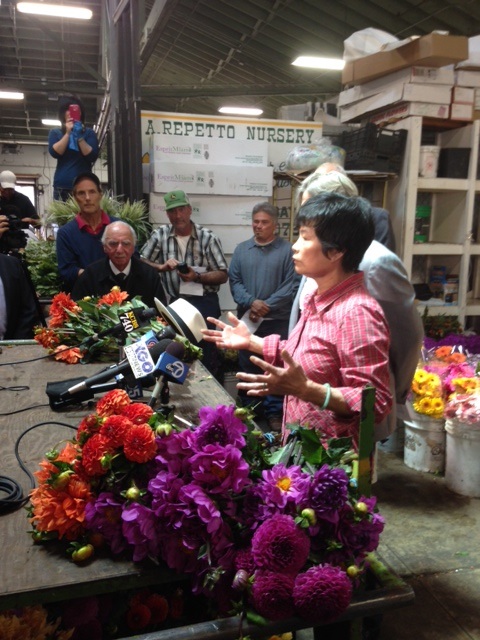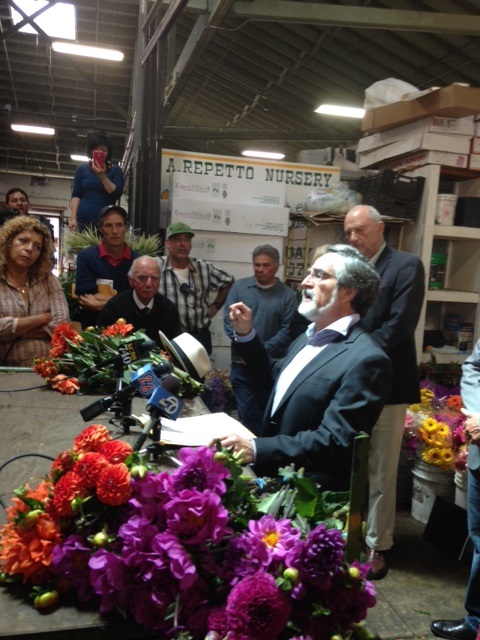
By Zelda Bronstein
The Flower Mart, a beloved San Francisco institution, is in danger of falling victim to the City Hall-stoked tech real estate boom.
The wholesale market for flowers, a staple for local florists at Sixth and Brannan since 1956 that Martha Stewart once called the “best flower market in the country,” could soon be bought by a real-estate developer, meaning the tenants may face eviction since the property is far more valuable if it’s turned into office space.
Although the headline in the July 25 Chronicle—“Developer acquires S.F. Flower Mart”— suggested that the market is doomed, the Mart can still be saved, and with it a big piece of the city’s old, industrial, blue-collar base.
But that will take a prompt and vigorous show of public support and political muscle.
The beginning of a campaign to save the Flower Mart was on view this week, as Mart tenants, joined by florists, flower market enthusiasts and advocates of an inclusive San Francisco, gathered for a noontime “Save the Flower Mart” press conference and rally in Repetto’s Nursery at the site.
Organized by Mart tenant Patrick McCann of Greenworks, the rally featured an impressive array of speakers: tenants David Repetto of Repetto’s Nursery, “Mama” Lee of SoMa Flowers, and Lupe Rico of Lassen Ranch; former State Senator Quentin Kopp; former Mayor Art Agnos; former Board of Supervisors President Aaron Peskin; District 6 Supervisor Jane Kim; Small Business Commissioner and florist Kathleen Dooley; and the grand old man of the city’s flower-selling industry, the proprietor of the “I. Magnin” flower stand, 92-year-old Albert Nalbandian.

Six years ago, then-Board of Supervisors President Peskin sank the Academy of Art’s attempt to buy the Flower Mart and turn it into sculpture studios.
Some of the Mart’s 100 tenants approached him and Agnos after the Los Angeles-based Kilroy Realty Corporation announced on July 11 that it had “executed a merger agreement to acquire all the outstanding shares” of the San Francisco Flower Growers Association, one of the three firms that own portions of the Mart site.
Describing the SFFGA as “a privately owned entity whose only material asset” is a 1.9 acre portion of the Flower Mart site, Kilroy said that the transaction was valued at about $27 million. The merger is contingent on its approval by a majority of the SFFGA stockholders in a September 11 vote.
Last Wednesday Agnos and Peskin presided over a meeting of 40-odd tenants in the patio of the Flower Mart Café. Both made it clear that they were neither running for office nor being paid to advocate the tenants’ cause. They were there, Agnos said, because protecting the flower market is “part of a struggle to save the heart and soul of this great city,” a fight that he linked to the defeat of the 8 Washington condo project at the polls last November and the successful defense of the tenants at the San Francisco Design Center at the BoS Land Use Committee in July.
A major impetus for the meeting was an August 19 letter that the SFFGA had sent to its sixty tenants, copies of which Peskin distributed to the group.
“Rest assured,” wrote SFFGA’s Ron Chiappari,
that an integral part of Kilroy’s development plan includes a new, state of the art Flower Mart enabling continued operations of present and future flower mart tenants and customers, as well as a plan for continuous operations of the Flower Mart during construction.Our understanding comes directly from the highest decision-makers at Kilroy and is consistent with the statements that John Kilroy, President, CEO, and Chairman of Kilroy, has made in the attached news article [the Chronicle story referenced above, which has been removed from the paper’s website].
Peskin, however, focused on another line in the letter:
“After the transaction has been completed[,] Kilroy will be able to meet with you on site, show you its preliminary plans, and seek your feedback.”

This, Peskin observed, was not at all reassuring. If the SFFGA and Kilroy really want to demonstrate their commitment to the tenants and the Mart, they should offer to meet with them and seek their input—not just their feedback—before the transaction is completed, not afterwards. Peskin also said that the developer had called him and asked him not to hold the meeting.
He went on to suggest terms that the tenants should ask Kilroy to guarantee in writing before the deal closed:
- no tenant will be displaced even temporarily under construction
- leases will be renewed (at affordable rates)
- tenants’ expenses due to the new construction will be paid for
- Kilroy will reveal its plans for the site and its management

A week later, neither Kilroy nor the SFFGA had contacted the tenants.
Addressing the rally, tenant David Repetto said, “We need long-term leases at rental rates that are affordable for small business….Kilroy also needs to tell us who will run the Flower Mart? Will it be the biggest tenants? Wholesalers? Retailers? Will it be democratically run? And we need professional management that understands the flower business, not just a real estate entity.”
According to McCann, what’s at stake is not just the 60 locally owned businesses that lease from the SFFGA but also the thousands of living-wage jobs provided by the growers, shippers, and truck drivers who supply our region’s 46,000 florists. The Flower Mart is one of only five such markets in the U.S. In most other places, florists have to drive around from small wholesaler to small wholesaler.
My North Berkeley neighborhood florist, Amir Abdolhosseini of Solano Flowers, was shocked to learn that the Mart might close. “The Flower Mart cannot disappear,” he said. “Where would people”—i.e., florists such as himself—“go to get their flowers?”
At last week’s tenants meeting, Peskin said he neither trusted nor distrusted Kilroy. But he told the rally that he’d changed his mind. That’s because former Planning Commissioner Bill Sugaya had just handed him the Planning Department’s preliminary assessment of what Kilroy is proposing for the SFFGA property at 575 Sixth Street: an 11-story, 160-foot-tall, 655,150-square-foot development separated into one nine-story building and one 11-story building, connected by pedestrian bridges at the fifth and sixth levels. The buildings would include 508,040 square feet of new office space, plus 16,410 square feet of retail on the ground floor. All structures on the site would be demolished. The proposal says nothing about phasing in existing businesses.
In other words, Kilroy has known for more than a year exactly what it’s proposing to build — and yet has said nothing to the Flower Mart’s tenants.
Peskin also noted that the Kilroy project “does not fit the current zoning.”
No kidding. For starters, the SALI (Service/Arts/Light Industrial) District prohibits offices. In addition, the proposed Floor Area Ratio (FAR) exceeds the allowed maximum, and the proposed 160-foot-tall building exceeds the current 40-55 foot height limit.
But like the many other big developers salivating over SoMa’s industrial lands, Kilroy is looking beyond the current zoning to the relaxed standards of the forthcoming Central SoMa Plan. As is their wont, the city’s planners have evaluated Kilroy’s proposal with respect to both current standards and to proposed zoning—in this case, proposals that won’t come before the Planning Commission, much less the Board of Supervisors, before next year.
To wit, the draft Central SoMa Plan would replace SALI with Mixed Use-Office (MUO), a category that exemplifies the Planning Department’s deregulatory approach to land use. In SoMA Leadership Council President Jim Meko’s memorable phrase, MUO is “zoning for people who don’t like zoning.” It permits just about everything but adult entertainment and heavy industry.
In another respect, however, the Kilroy project would be inconsistent even with the relaxed development standards of the proposed Central SoMa Plan. The city’s planners want to raise the height allowances on the block from 40-55 feet to either 55/65 feet or 65/85 feet—significantly less than the 160 feet Kilroy hopes to construct.
At the rally, Supervisor Kim announced that at the September 9th Board meeting, she would be proposing that interim controls that would prohibit conversions from Production, Distribution and Repair (PDR), i.e., light industry, to office or residential during the time the Central SoMa Plan is under deliberation and encourage the Planning Department “to work with the developer to ensure the vibrancy of the Flower Mart.”
That’s a step in the right direction.
But it’s going to take far more than interim controls and requests that the planners work with the developer to protect the Flower Mart and the rest of SoMa’s light industrial economy. As 48 hills reported last winter, the Central SoMa Plan is openly premised on the destruction of that economy and its replacement by a high-rise, high-rent, tech-dominated second Downtown.
The Planning Department says the Central SoMa Plan emerged out of “a community planning process.” When did the “community” embrace the elimination of 1,800 blue-collar jobs (that’s Planning’s figure, not mine), including the jobs at the Flower Mart?
As for the Flower Mart: The city’s planners, too, have known for well over a year what Kilroy intends to do at 575 Sixth Street. Why haven’t they come forward and supported the tenants, or at least informed them about the proposed project?
At the rally, Art Agnos said he’d called Mayor Lee and asked him to bring his Planning Department and Kilroy to the Mart and tell the tenants what they’re going to do to protect them. Will the mayor accept that invitation?




